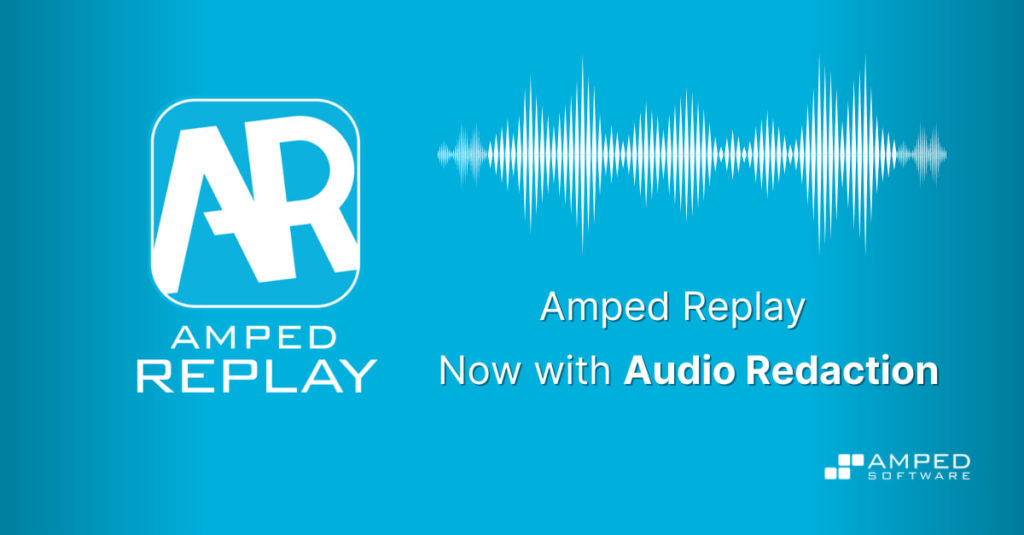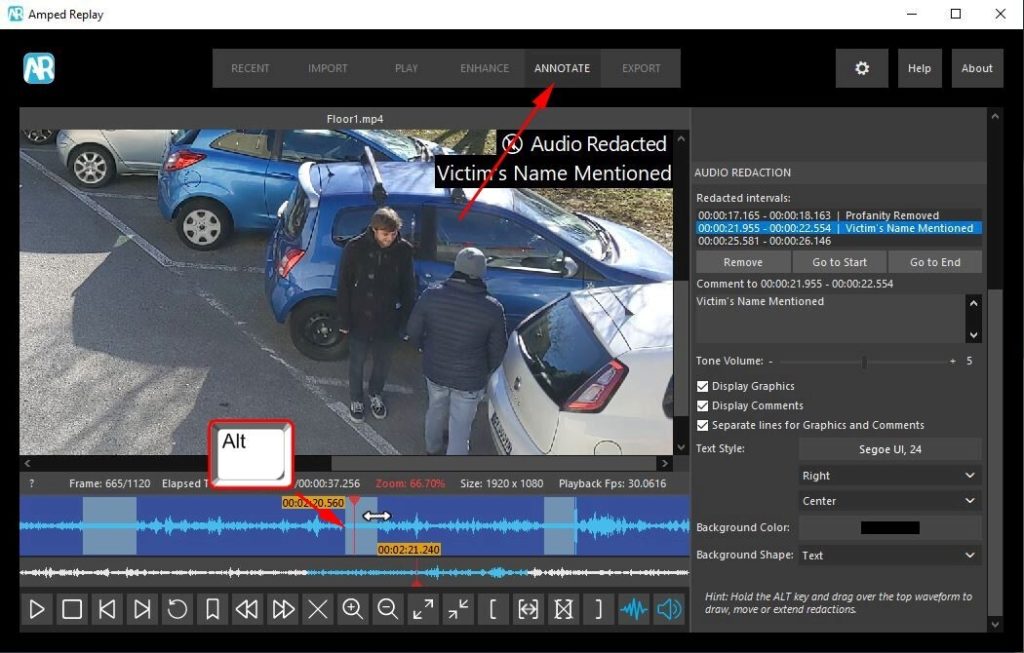
Dear colleagues, we are very thrilled to introduce you to the new exciting audio display and redaction features now available in Amped Replay! Additions that required weeks of intense development and testing, but which we are immensely proud of. And we think you are going to love how easy it is now to remove sensitive audio from your evidence!
In the past, removing sensitive and/or unwanted material from digital media evidence was considered a niche editing skill that only a specialized video unit could undertake in a law enforcement agency. And there was a good reason for it, of course. The process required ingesting the evidence, editing the material and exporting the processed media to a forensically acceptable standard. This is a delicate workflow that requires specialized training and skill set in forensic video processing and analysis.
Now with Amped Replay, forensic integrity and quality is taken care of for you in the background. Meanwhile, you can focus on removing visual, and now aural, content that is inadmissible in court, or not fit for public disclosure.
So, without further ado, let’s load a video with sound and start redacting!
Viewing the Audio Plot
When we agreed to develop an audio redaction feature in Amped Replay, we soon realized that we first needed a visual representation of the audio plot to ensure the redacting process is as easy and intuitive as possible. The plot illustrates the volume peaks over time in the sound track. It makes it quick to locate a portion of speech or audio of interest in a short clip. Less easy when we are dealing with very long clips, however.
So, we now have the audio plot clearly displayed under the viewer. Additionally, we have the ability to zoom in and out the plot. It is as easy as using the scroll wheel on your mouse!
You will first notice that when you have a clip with sound loaded in the program, two waveforms are now displayed by default.

Audio Bar
The top bar (or Audio bar) displays the audio plot for the zoomed portion of the video only. Simply hover over the area of interest within this bar. Use the scroll wheel on your mouse to zoom in and out of that area, as required. You can also hold down the CTRL key. Click the left and right mouse buttons to zoom in and out instead of using the scroll wheel.

Video Bar
The bottom bar (or Video bar) now displays the waveform for the whole clip, however long that may be. And, it will still contain other video idents such as bookmarks, any range selections and, of course, annotation markers and key frames, where present. Furthermore, it also now displays a blue-highlighted range to indicate which portion of the audio plot is currently displayed in the top bar.
You can still click anywhere on the plot to move the bottom play head and the corresponding range to that position. Or, you can just click and drag the highlighted range left and right to display that full range in the top Audio bar. Of course, you can also click anywhere on the top Video bar to move the top play head to that location.
But what about if we have a clip with sound, of which we are only interested in the video? Is there a way to hide the waveform? Of course there is. The plot can be quite distracting if all you are interested in is to enhance or annotate the video. You may just want to toggle it on and off as you work. So, we have added a new Waveform button – adjacent to the Mute button – which will do just that.

New Program Options Menu
But we’ve even gone a step further. With the introduction of the new Program Options menu, accessible by clicking on the cogwheel button at the top right of the interface, you can now also set Amped Replay to always show the audio waveform display, or otherwise, in the Play tab. When switching to the Annotate and Export tabs, however, the waveform will always be enabled by default. This to remind you that the video has audio. You may need to perform some redactions prior to export. If you wish to hide the plot when in these tabs, you can still do so by clicking on the Waveform button.

Remove Sensitive Audio
Now that we’ve learned how to view the audio plot and how to customize our waveform preferences, let’s start to remove sensitive audio. There may be some confidential information (such as a witness’ address). It may need to be omitted for court presentation, or perhaps some profanity that needs removing prior to release by the media. With Amped Replay, doing this is now as easy as holding the ALT button down and drawing on the relevant portion of the waveform with the mouse.
First of all, load your clip and select a range of frames (if required). Then, click on the Annotate tab to enable the Audio Redaction features. Although you can preview the audio plot in any tabs, you can only actually remove sections of audio when the Annotate tab is selected.
Sound Redaction
Identify your first portion of sound to be redacted. Zoom in on the waveform to help you locate the beginning and end of your redaction. This is especially useful when working with long clips and/or when redacting very small portions of sound.
Hold down the ALT button on your keyboard and notice how your mouse cursor changes to a double arrow. As you hold down the ALT button, left click at the beginning of the redaction in the top Audio bar. Drag the selection all the way to the end of the redaction.
You can then release the mouse button and the ALT key. Please note, however, that you cannot create redactions by clicking on the bottom Video bar.


You can trim an existing redaction by holding the ALT button again and by dragging the edges of the redacted range as required. You can also delete a redaction by holding the left mouse button down on it while pressing DEL on your keyboard.
The redacted sound will be replaced with an industry standard 1 khz tone. There will also be a textual slate displayed on the video for the duration of that redaction. You can change the volume of the tone by moving the Tone Volume slider left and right. This is located in the Audio Redaction panel, underneath the Annotate panel. If you move the slider all the way to the left (“Volume 0”), the redacted sound will simply be replaced by silence. This is also a smart way to remove short segments of unwanted sound.
Multiple Redactions
As you add multiple redactions to your clip (and you can add as many as you like), you will notice they will be listed by timestamps in the Redacted Intervals box in the Audio Redaction panel. You can go back to the beginning or end of any redaction you have already created by selecting the relevant entry in the list and by clicking on the “Go to Start” and “Go to End” buttons, respectively. With an entry selected, you can also delete it by clicking on the Remove button.
Textual Comments
If you wish, you can also add a textual comment to any of the redactions by selecting one in the Redacted Intervals list first and by typing the required textual content in the text box underneath.

Additional Customizations
Also available in the Audio Redaction panel are further customizations on how you wish to display redactions on the screen. For example, you may wish to display the standard textual redaction graphic and the individual textual comments in two separate lines of text. You may simply wish not to display these at all. All you need to do is tick and untick the relevant options available to you.
And finally, you have, of course, the option to change the location, font, size and color of your textual content. Additionally, you have the ability to add a background underneath the text and to change the color of the background as well. These options should already be familiar to you as they are identical to those pertaining to textual annotations.

Once you’re finished, all you need to do is click on the Export tab. Then, click on the Export Processed Video as MP4 button to output your redacted video. Of course, before you do so, you can still enhance and/or annotate your video, as required.
If you generate a report, a list of all the redactions you have done on your video, as well as their corresponding timestamps and textual comments, will be included. As a result, you will have an auditable account of what you have removed from the original video and why you have done so.
Conclusion
And that’s it! You should now have a general understanding of how to navigate through the waveform of a clip and how to redact sensitive and unwanted audio from your evidence. Let us know what you think of this new feature on Discord. If you are not registered yet, well, do it today!




